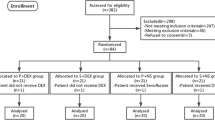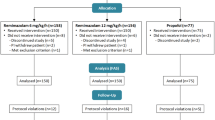Abstract
The effects of clonidine as a preanesthetic medication were compared with diazepam on clinical courses of sevoflurane anesthesia in 22 patients undergoing upper abdominal surgery. The patients were divided into two groups of 11 patients each according to preanesthetic medication: atropine 0.5 mg i.m. plus clonidine 0.3 mg p.o., or atropine 0.5 mg i.m. plus diazepam 10 mg p.o. 60–90 min prior to induction of anesthesia. Anesthesia was induced with fentanyl and thiopental, and was maintained with sevoflurane, 0.5%–1.5%, nitrous oxide and oxygen, supplemented with fentanyl, 0.5 μg·kg−1·hr−1. While only one patient needed a vasodilator in the clonidine group for treatment of hypertension, seven patients needed it in the diazepam group. Pain score after extubation was higher in the diazepam group than in the clonidine group. The time when patients responded to verbal command after discontinuation of anesthetics was similar in both groups. Therefore, clonidine pretreatment was useful for sevoflurane anesthesia in upper abdominal surgery.
Similar content being viewed by others
References
Eger EI II, Johnson BH (1987) Rates of awaking from anesthesia with I-653, halothane, isoflurane, and sevoflurane: A test of the effect of anesthetic concentration and duration in rats. Anesth Analg 66:977–982
Kazama T, Ikeda K (1988) Comparison of MAC and the rate of rise of alveolar concentration of sevoflurane with halothane and isoflurane in the dog. Anesthesiology 68:435–437
Stern RC, Towler SC White PF, et al. (1990) Elimination kinetics of sevoflurane and halothane from blood, brain, and adipose tissue in the rat. Anesth Analg 71:658–664
Yasuda N, Lockhart SH, Eger EI II et al. (1991) Comparison of kinetics of sevoflurane in humans. Anesth Analg 72:316–324
Naito Y, Tamai S, Shingu K, et al. (1991) Comparison between sevoflurane and halothane for paediatric ambulatory anaesthesia. Br J Anaesth 67:387–389
Osawa M, Shingu K, Tomoda K, et al. (1991) Effect of sevoflurane on the brain electrical activities in cats (in Japanese, with English abstract). Masui (Jpn J Anesthesiol) 40:S178
Ghignone M, Quintin L, Duke PC, et al. (1986) Effects of clonidine on narcotic requirements and hemodynamic response during induction of fentanyl anaesthesia and endotracheal intubation. Anesthesiology 64:36–42
Ghignone M, Calvillo O, Quintin L (1987) Anesthesia and hypertension: The effect of clonidine on perioperative hemodynamics and isoflurane requirements. Anesthesiology 67:3–10
Orko R, Pouttu J, Ghignone M, et al. (1987) Effect of clonidine on haemodynamic responses to endotracheal intubation and gastric acidity. Acta Anaesthesiol Scand 31:325–329
Pouttu J, Scheinin B, Rosenberg PH, et al. (1987) Oral premedication with clonidine: Effects on stress responses during general anaesthesia. Acta Anaesthesiol Scand 31:730–734
Ghignone M, Noe C, Calvillo O, et al. (1988) Anesthesia for ophthalmic surgery in the elderly: The effects of clonidine on intraocular pressure, perioperative hemodynamics, and anesthetic requirement. Anesthesiology 68:707–716
Flacke JW, Bloor BC, Flacke WE, et al. (1987) Reduced narcotic requirement by clonidine with improved hemodynamic and adrenergic stability in patients undergoing coronary bypass surgery. Anesthesiology 67:11–19
Engelman E, Lipszyc M, Gilbart E, et al. (1989) Effects of clonidine on anesthetic drug requirements and hemodynamic response during aortic surgery. Anesthesiology 71:178–187
Woodcock TE, Millard RK, Dixon J, et al. (1988) Clonidine premedication for isoflurane-induced hypotension. Br J Anaesth 60:388–394
Murakawa T, Satoh Y, Kudo T, et al. (1989) Effects of sevoflurane anaesthesia and surgery on plasma catecholamine levels (in Japanese, with English abstract). Masui (Jpn J Anesth) 38:1456–1462
Heinonen J, Takkunen O (1977) Bradycardia during antagonism of pancuronium-induced neuromuscular block. Br J Anaesth 49:1109–1115
Heinonen J, Salmenperä M, Takkunen O (1981) Haemodynamic responses to antagonism of pancuroium and alcuronium block. Acta Anaesthesiol Scand 25:1–5
Stovner J, Oftedal N, Holmboe J (1975) The inhibition of cholinesterases by pancuronium. Br J Anaesth 47:949–954
Louis WJ, Anavekar SN, Conway EL, et al. (1983) Relationship of immunoassayable clonidine plasma levels to its pharmacologic action in clinical and experimental hypertension. Chest 83 [Suppl]: 352–354
Author information
Authors and Affiliations
About this article
Cite this article
Shingu, K., Iwatani, Y., Furutani, H. et al. Clonidine premedication for sevoflurane anesthesia in upper abdominal surgery. J Anesth 8, 21–24 (1994). https://doi.org/10.1007/BF02482747
Received:
Accepted:
Issue Date:
DOI: https://doi.org/10.1007/BF02482747




